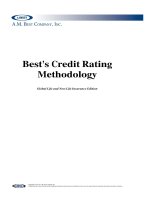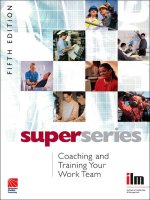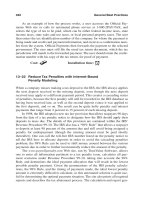Accounting Best Practices, Fifth Edition pot
Bạn đang xem bản rút gọn của tài liệu. Xem và tải ngay bản đầy đủ của tài liệu tại đây (3.79 MB, 509 trang )
Accounting
Best Practices
Fifth Edition
Steven M. Bragg
John Wiley & Sons, Inc.
ch00_FM_4773.qxd 12/29/06 9:07 AM Page iii
ch00_FM_4773.qxd 12/29/06 9:07 AM Page vi
Accounting
Best Practices
Fifth Edition
ch00_FM_4773.qxd 12/29/06 9:07 AM Page i
BECOME A SUBSCRIBER!
Did you purchase this product from a bookstore?
If you did, it’s important for you to become a subscriber. John Wiley & Sons, Inc. may publish,
on a periodic basis, supplements and new editions to reflect the latest changes in the subject
matter that you need to know in order to stay competitive in this ever-changing industry. By
contacting the Wiley office nearest you, you’ll receive any current update at no additional
charge. In addition, you’ll receive future updates and revised or related volumes on a 30-day
examination review.
If you purchased this product directly from John Wiley & Sons, Inc., we have already recorded
your subscription for this update service.
To become a subscriber, please call 1-800-225-5945 or send your name, company name (if
applicable), address, and the title of the product to:
mailing address: Supplement Department
John Wiley & Sons, Inc.
One Wiley Drive
Somerset, NJ 08875
e-mail:
fax: 1-732-302-2300
online: www.wiley.com
For customers outside the United States, please contact the Wiley office nearest you:
Professional & Reference Division John Wiley & Sons, Ltd.
John Wiley & Sons Canada, Ltd. Baffins Lane
22 Worcester Road Chichester
Rexdale, Ontario M9W 1L1 West Sussex, PO19 1UD
CANADA ENGLAND
(416) 675-3580 Phone: (44) 1243 779777
Phone: 1-800-567-4797 Fax: (44) 1243 770638
Fax: 1-800-565-6802
Jacaranda Wiley Ltd. John Wiley & Sons (SEA) Pte. Ltd.
PRT Division 2 Clementi Loop #02-01
P.O. Box 174 SINGAPORE 129809
North Ryde, NSW 2113 Phone: 65 463 2400
AUSTRALIA Fax: 65 463 4605; 65 463 4604
Phone: (02) 805-1100
Fax: (02) 805-1597
headoffi
ch00_FM_4773.qxd 12/29/06 9:07 AM Page ii
Accounting
Best Practices
Fifth Edition
Steven M. Bragg
John Wiley & Sons, Inc.
ch00_FM_4773.qxd 12/29/06 9:07 AM Page iii
This book is printed on acid-free paper.
Copyright © 2007 by John Wiley & Sons. All rights reserved.
Wiley Bicentennial Logo: Richard J. Pacifico
Published by John Wiley & Sons, Inc., Hoboken, New Jersey.
Published simultaneously in Canada.
No part of this publication may be reproduced, stored in a retrieval system, or transmitted in
any form or by any means, electronic, mechanical, photocopying, recording, scanning, or oth-
erwise, except as permitted under Section 107 or 108 of the 1976 United States Copyright Act,
without either the prior written permission of the Publisher, or authorization through payment
of the appropriate per-copy fee to the Copyright Clearance Center, Inc., 222 Rosewood Drive,
Danvers, MA 01923, 978-750-8400, fax 978-646-8600, or on the Web at www.copyright.com.
Requests to the Publisher for permission should be addressed to the Permissions Department,
John Wiley & Sons, Inc., 111 River Street, Hoboken, NJ 07030, 201-748-6011, fax 201-748-
6008, or online at www.wiley.com/go/permissions.
Limit of Liability/Disclaimer of Warranty: While the publisher and author have used their best
efforts in preparing this book, they make no representations or warranties with respect to the
accuracy or completeness of the contents of this book and specifically disclaim any implied
warranties of merchantability or fitness for a particular purpose. No warranty may be created
or extended by sales representatives or written sales materials. The advice and strategies con-
tained herein may not be suitable for your situation. You should consult with a professional
where appropriate. Neither the publisher nor author shall be liable for any loss of profit or any
other commercial damages, including but not limited to special, incidental, consequential, or
other damages.
For general information on our other products and services, or technical support, please contact
our Customer Care Department within the United States at 800-762-2974, outside the United
States at 317-572-3993 or fax 317-572-4002.
Wiley also publishes its books in a variety of electronic formats. Some content that appears in
print may not be available in electronic books.
For more information about Wiley products, visit our Web site at www.wiley.com.
Library of Congress Cataloging-in-Publication Data:
ISBN: 9780470081822
Printed in the United States of America
10987654321
ch00_FM_4773.qxd 12/29/06 9:07 AM Page iv
To John DeRemigis, who convinced me
that this was a good idea
ch00_FM_4773.qxd 12/29/06 9:07 AM Page v
ch00_FM_4773.qxd 12/29/06 9:07 AM Page vi
About the Author
Steven Bragg, CPA, CMA, CIA, CPM, CPIM, has been the chief financial offi-
cer or controller of four companies, as well as a consulting manager at Ernst &
Young and auditor at Deloitte & Touche. He received a master’s degree in finance
from Bentley College, an MBA from Babson College, and a bachelor’s degree in
economics from the University of Maine. He has been the two-time president of
the Colorado Mountain Club, and is an avid alpine skier, mountain biker, and cer-
tified master diver. Mr. Bragg resides in Centennial, Colorado. He has written the
following books published by John Wiley & Sons:
Accounting and Finance for Your Small Business
Accounting Best Practices
Accounting Control Best Practices
Accounting Reference Desktop
Billing and Collections Best Practices
Business Ratios and Formulas
Controller’s Guide to Costing
Controller’s Guide to Planning and Controlling Operations
Controller’s Guide: Roles and Responsibilities for the New Controller
Controllership
Cost Accounting
Design and Maintenance of Accounting Manuals
Essentials of Payroll
Fast Close
Financial Analysis
GAAP Guide
GAAP Implementation Guide
Inventory Accounting
Inventory Best Practices
Just-in-Time Accounting
Managing Explosive Corporate Growth
Outsourcing
vii
ch00_FM_4773.qxd 12/29/06 9:07 AM Page vii
Payroll Accounting
Payroll Best Practices
Revenue Recognition
Sales and Operations for Your Small Business
The Controller’s Function
The New CFO Financial Leadership Manual
The Ultimate Accountants’Reference
Also:
Advanced Accounting Systems (Institute of Internal Auditors)
Run the Rockies (CMC Press)
viii About the Author
ch00_FM_4773.qxd 12/29/06 9:07 AM Page viii
Free On-Line Resources
by Steve Bragg
Steve issues a free accounting best practices newsletter as well as frequent addi-
tional blog postings, and an accounting best practices podcast. You can sign up for
free delivery of both at www.stevebragg.com.
ix
ch00_FM_4773.qxd 12/29/06 9:07 AM Page ix
ch00_FM_4773.qxd 12/29/06 9:07 AM Page x
Contents
Preface xiii
Chapter 1 Introduction 1
Chapter 2 How to Use Best Practices 4
Chapter 3 Accounts Payable Best Practices 18
Chapter 4 Billing Best Practices 81
Chapter 5 Budgeting Best Practices 103
Chapter 6 Cash Management Best Practices 129
Chapter 7 Credit and Collections Best Practices 145
Chapter 8 Commissions Best Practices 187
Chapter 9 Costing Best Practices 200
Chapter 10 Filing Best Practices 221
Chapter 11 Finance Best Practices 244
Chapter 12 Financial Statements Best Practices 266
Chapter 13 General Best Practices 295
Chapter 14 General Ledger Best Practices 333
Chapter 15 Internal Auditing Best Practices 352
Chapter 16 Inventory Best Practices 370
Chapter 17 Payroll Best Practices 414
Chapter 18 Policies in Support of Best Practices 445
Appendix A Summary of Best Practices 454
Appendix B Supplier Contact Information 471
Index 483
xi
ch00_FM_4773.qxd 12/29/06 9:07 AM Page xi
xii Contents
IMPORTANT NOTE:
Because of the rapidly changing nature of information in this field, this prod-
uct may be updated with annual supplements or with future editions.
Please
call 1-877-762-2974 or e-mail us at to receive
any current update at no additional charge.
We will send on approval any
future supplements or new editions when they become available. If you pur-
chased this product directly from John Wiley & Sons, Inc., we have already
recorded your subscription for this update service.
ch00_FM_4773.qxd 12/29/06 9:07 AM Page xii
Preface
The accounting department is a cost center. It does not directly generate revenues,
but rather provides a fixed set of services to the rest of the company, and is asked
to do so at the lowest possible cost. Consequently, the accounting staff is called
upon to process transactions, write reports, create new processes or investigate
old ones—while doing so as an ever-shrinking proportion of total corporate
expenses.
This cost-based environment is a very difficult one for most accountants, for
their training is primarily in accounting rules and regulations, rather than in how
to run a very specialized department in a cost-effective manner. They find a few
ideas for improvements from attending seminars or perusing accounting or man-
agement magazines, but there is no centralized source of information for them to
consult that itemizes a wide array of possible improvements. Hence the need for the
fifth edition of Accounting Best Practices, which contains 395 accounting best
practices, of which 61 are new to this edition.
This book is compiled from the author’s lengthy experience in setting up
and operating a number of accounting departments, as well as by providing con-
sulting services to other companies. Accordingly, it contains a blend of best
practices from a wide variety of accounting environments, ranging from small
partnerships to multibillion-dollar corporations. This means that not all of the
best practices described within these pages will be useful in every situation—
some are designed to provide quick and inexpensive, incremental improvements,
while others are groundbreaking events requiring six-figure investments (or more)
and months of installation time. Consequently, each chapter includes a table that
notes the ease, duration, and cost of implementation for every best practice
within it. These tables separate best practices into a number of subcategories,
and also contain a reference number that is useful for locating the main text for
each best practice within the chapter. Also, a selection of best practices have an
“Author’s Choice” graphic posted next to them. These best practices are ones the
author has found to be particularly effective in improving accounting operations.
All best practices are also noted in summary form in Appendix A. In addition,
Appendix B contains contact information for most of the suppliers listed in this
book.
xiii
ch00_FM_4773.qxd 12/29/06 9:07 AM Page xiii
Though this book is the central source of best practices information for the
accountant, there are several other books available that specialize in smaller niches
within the accounting area. Each of these books contains many additional best
practices not found in Accounting Best Practices. These include the author’s Inven-
tory Best Practices (Wiley, 2004), Billing and Collections Best Practices (Wiley,
2005), Payroll Best Practices (Wiley, 2005), and Fast Close (Wiley, 2005).
STEVEN M. BRAGG
Centennial, Colorado
July 2006
xiv Preface
ch00_FM_4773.qxd 12/29/06 9:07 AM Page xiv
Accounting
Best Practices
Fifth Edition
ch00_FM_4773.qxd 12/29/06 9:07 AM Page xv
ch00_FM_4773.qxd 12/29/06 9:07 AM Page xvi
Chapter 1
Introduction
A chief executive officer (CEO) spends months deciding on a corporate strategy.
The plan probably includes a mix of changes in products, customers, and mar-
kets, as well as demands for increased efficiencies or information in a number of
existing areas. The CEO then hands off the plan to a group of managers who are
quite capable of implementing many of the changes, but who scratch their heads
over how to squeeze greater efficiencies or information out of existing depart-
ments in order to meet their strategic goals. This is where best practices come
into play.
A best practice is really any improvement over existing systems, though
some consultants prefer to confine the definition to those few high-end and very
advanced improvements that have been successfully installed by a few world-
class companies. This book uses the broader definition of any improvement over
existing systems, since the vast majority of companies are in no position, in terms
of either technological capabilities, monetary resources, or management skill, to
make use of truly world-class best practices. Using this wider definition, a best
practice can be anything that increases the existing level of efficiency, such as
switching to blanket purchase orders, signature stamps, and procurement cards to
streamline the accounts payable function. It can also lead to improved levels of
reporting for use by other parts of the company, such as activity-based costing,
target costing, or direct costing reports in the costing function. Further, it can
reduce the number of transaction errors, by such means as automated employee
expense reports, automated bank account deductions, or a simplified commission
calculation system. By implementing a plethora of best practices, a company can
greatly improve its level of efficiency and information reporting, which fits nicely
into the requirements of most strategic plans.
One can go further than describing best practices as an excellent contributor
to the fulfillment of a company’s strategy, and even state that a strategy does not
have much chance of success unless best practices are involved. The reason is
that best practices have such a large impact on overall efficiencies, they unleash a
large number of excess people who can then work on other strategic issues, as
well as reduce a company’s cash requirements, releasing more cash for invest-
ment in strategic targets. In addition, some best practices link company functions
more closely together, resulting in better overall functionality—this is a singular
improvement when a company is in the throes of changes caused by strategy
shifts. Further, best practices can operate quite well in the absence of a strategic
1
ch01_4773.qxd 12/29/06 8:53 AM Page 1
plan. For example, any department manager can install a variety of best practices
with no approval or oversight from above, resulting in a multitude of beneficial
changes. Thus, best practices are a linchpin of the successful corporate strategy,
and can also lead to improvements even if they are not part of a grand strategic
vision.
The scope of this book does not encompass all of the best practices that a
company should consider, only those used by the accounting department. This
area is especially susceptible to improvement through best practices, since it is heavily
procedure-driven. When there are many procedures, there are many opportunities
to enhance the multitude of procedure steps through automation, simplification,
elimination of tasks, error-proofing, and outsourcing. Thus, of all the corporate
functions, this is the one that reacts best to treatment through best practices.
Chapter 2 covers a variety of issues related to the implementation of best
practices, such as differentiating between incremental and reengineering changes,
circumstances under which best practices are most likely to succeed, and how to
plan and proceed with these implementations. Most important, there is a discus-
sion of the multitude of reasons why a best practice implementation can fail,
which is excellent reading prior to embarking on a new project, in order to be
aware of all possible pitfalls. The chapter ends with a brief review of the impact
of best practices on employees. This chapter is fundamental to the book, for it
serves as the groundwork on which the remaining chapters are built. For example,
if you are interested in modifying the general ledger account structure for use by
an activity-based costing system, it is necessary to first review the implementa-
tion chapter to see how any programming, software package, or interdepartmental
issues might impact the project.
Chapters 3 through 17 each describe a cluster of best practices, with a func-
tional area itemized under each chapter. For example, Chapter 8 covers a variety
of improvements to a company’s commission calculation and payment systems,
while Chapter 17 is strictly concerned with a variety of payroll-streamlining
issues related to the collection of employee time information, processing it into
payments, and distributing those payments. Chapter 13 is a catchall chapter. It
covers a variety of general best practices that do not fit easily into other, more
specific chapters. Examples of these best practices are the use of process-centering,
on-line reporting, and creating a contract-terms database. Chapters 3 through 17
are the heart of the book since they contain information related to nearly 400 best
practices.
For Chapters 3 through 17, there is an exhibit near the beginning that shows
the general level of implementation cost and duration for each of the best prac-
tices in the chapter. This information gives the reader a good idea of which best
practices to search for and read through, in case these criteria are a strong consid-
eration. For each chapter, there are a number of sections, each one describing a
best practice. There is a brief description of the problems it can fix, as well as notes
on how it can be implemented, and any problems one may encounter while doing so.
Each chapter concludes with a section that describes the impact of a recommended
2 Introduction
ch01_4773.qxd 12/29/06 8:53 AM Page 2
mix of best practices on the functional area being covered. This last section almost
always includes a graphical representation of how certain best practices impact
specific activities. Not all the best practices in each chapter are included in this
graphic, since some are mutually exclusive. This chapter layout is designed to give
the reader a quick overview of the best practices that are most likely to make a
significant impact on a functional area of the accounting department.
Chapter 18 contains a set of policies designed to assist in best practices imple-
mentations. Appendix A lists all of the best practices in each of the preceding
chapters. This list allows the reader to quickly find a potentially useful best prac-
tice. It is then a simple matter to refer back to the main text to obtain more informa-
tion about each item. Appendix B contains contact information for every supplier
listed in this book, in case the reader wants additional information related to spe-
cific suppliers.
This book is designed to assist anyone who needs to either improve the effi-
ciency of the accounting department, reduce its error rates, or provide better infor-
mation to other parts of a company. The best practices noted on the following
pages will greatly assist in attaining this goal, which may be part of a grand strate-
gic vision or simply a desire by an accounting manager to improve the department.
The layout of the book is extremely practical: to list as many best practices as pos-
sible, to assist the reader in finding the most suitable ones, and to describe any
implementation problems that may arise. In short, this is the perfect do-it-yourself
fix-it book for the manager who likes to tinker with the accounting department.
Introduction 3
ch01_4773.qxd 12/29/06 8:53 AM Page 3
Chapter 2
How to Use Best Practices
This chapter is about implementing best practices. It begins by describing the
various kinds of best practices and goes on to cover those situations where they
are most likely to be installed successfully. The key components of a successful
best practice installation are also noted. When planning to add a best practice, it
is also useful to know the ways in which the implementation can fail, so there is a
lengthy list of reasons for failure. Finally, there is a brief discussion of the impact
of change on employees and the organization. Only by carefully considering all
of these issues in advance can one hope to achieve a successful best practice
implementation that will result in increased levels of efficiency in the accounting
department.
Types of Best Practices
This section describes the two main types of best practices, each one requiring
considerably different implementation approaches.
The first type of best practice is an incremental one. This usually involves
either a small modification to an existing procedure or a replacement of a proce-
dure that is so minor in effect that it has only a minimal impact on the organiza-
tion, or indeed on the person who performs the procedure. The increased level of
efficiency contributed by a single best practice of this type is moderate at best,
but this type is also the easiest to install, since there is little resistance from the
organization. An example of this type of best practice is using a signature stamp
to sign checks (see Chapter 3); it is simple, cuts a modest amount of time from
the check preparation process, and there will be no complaints about its use.
However, only when this type of best practice is used in large numbers is there a
significant increase in the level of efficiency of accounting operations.
The second type of best practice involves a considerable degree of reengi-
neering. This requires the complete reorganization or replacement of an existing
function. The level of change is massive, resulting in employees either being laid
off or receiving vastly different job descriptions. The level of efficiency improve-
ment can be several times greater than the old method it is replacing. However, the
level of risk matches the reward, for this type of best practice meets with enor-
mous resistance and consequently is at great risk of failure. An example of this
type of best practice is eliminating the accounts payable department in favor of
4
ch02_4773.qxd 12/29/06 9:08 AM Page 4
having the receiving staff approve all payments at the receiving dock (see Chapter
3); it involves the elimination of many jobs and is an entirely new approach to pay-
ing suppliers. A single best practice implementation of this sort can reap major
improvements in the level of accounting efficiency.
Thus, given the considerable number and size of the differences between the
incremental and reengineering best practices, it is necessary to first determine
into which category a best practice falls before designing a plan for implement-
ing it. Given the difficulty of implementation for a reengineering project, it may
even be necessary to delay implementation or intersperse a series of such projects
with easier incremental projects, in order to allow employees to recover from the
reengineering projects.
The Most Fertile Ground for Best Practices
Before installing any best practice, it is useful to review the existing environment
to see if there is a reasonable chance for the implementation to succeed. The fol-
lowing bullet points note the best environments in which best practices not only
can be installed, but also have a fair chance of continuing to succeed:
• If benchmarking shows a problem. Some organizations regularly compare
their performance levels against those of other companies, especially those
with a reputation for having extremely high levels of performance. If there is
a significant difference in the performance levels of these other organizations
and the company doing the benchmarking, this can serve as a reminder that
continuous change is necessary in order to survive. If management sees and
heeds this warning, the environment in which best practices will be accepted
is greatly improved.
• If management has a change orientation. Some managers have a seemingly
genetic disposition toward change. If an accounting department has such a
person in charge, there will certainly be a drive toward many changes. If any-
thing, this type of person can go too far, implementing too many projects
with not enough preparation, resulting in a confused operations group whose
newly revised systems may take a considerable amount of time to untangle.
The presence of a detail-oriented second-in-command is very helpful for
preserving order and channeling the energies of such a manager into the
most productive directions.
•
If the company is experiencing poor financial results. If there is a significant
loss, or a trend in that direction, this serves as a wake-up call to management,
which in turn results in the creation of a multitude of best practices projects.
In this case, the situation may even go too far, with so many improvement
projects going on at once that there are not enough resources to go around,
resulting in the ultimate completion of few, if any, of the best practices.
The Most Fertile Ground for Best Practices 5
ch02_4773.qxd 12/29/06 9:08 AM Page 5
• If there is new management. Most people who are newly installed as managers
of either the accounting department or (better yet) the entire organization
want to make changes in order to leave their marks on the organization. Though
this can involve less effective practice items like organizational changes or a
new strategic direction, it is possible that there will be a renewed focus on
efficiency that will result in the implementation of new best practices.
In short, as long as there is a willingness by management to change and a good
reason for doing so, then there is fertile ground for the implementation of a mul-
titude of best practices.
Planning for Best Practices
A critical issue for the success of any best practices implementation project is an
adequate degree of advance planning. The following bullet points describe the
key components of a typical best practices implementation plan:
• Capacity requirements. Any project plan must account for the amount of
capacity needed to ensure success. Capacity can include the number of people,
computers, or floor space that is needed. For example, if the project team
requires 20 people, then there must be a planning item to find and equip a
sufficient amount of space for this group. Also, a project that requires a con-
siderable amount of programming time should reserve that time in advance
with the programming staff to ensure that the programming is completed on
time. Further, the management team must have a sufficient amount of time
available to properly oversee the project team’s activities. If any of these
issues are not addressed in advance, there can be a major impact on the suc-
cess of the implementation.
• Common change calendar. If there are many best practices being implemented
at the same time, there is a high risk that resources scheduled for one project
will not be available for other projects. For example, a key software developer
may receive independent requests from multiple project teams to develop soft-
ware, and cannot satisfy all the requests. To avoid this, one should use a sin-
gle change calendar, so that planned changes can be seen in the context of
other changes being planned. The calendar should be examined for conflicts
every time a change is made to it, and also be made available for general
review, so that all project teams can consult it whenever needed.
•
Contingencies. Murphy’s Law always applies, so there should be contingen-
cies built into the project plan. For example, if the project team is being set
up in a new building, there is always a chance that phone lines will not be
installed in time. To guard against this possibility, there should be an additional
project step to obtain some cellular phones, which will supply the team’s
communications needs until the phone lines can be installed.
6 How to Use Best Practices
ch02_4773.qxd 12/29/06 9:08 AM Page 6









